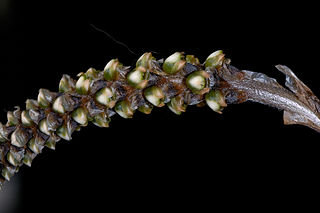
Aa is a genus of plants of the family Orchidaceae.

Cortaderia is a genus of South American and Central American plants in the Poaceae grass family.

Chusquea is a genus of evergreen bamboos in the grass family. Most of them are native to mountain habitats in Latin America, from Mexico to southern Chile and Argentina.

Oncidium, abbreviated as Onc. in the horticultural trade, is a genus that contains about 330 species of orchids from the subtribe Oncidiinae of the orchid family (Orchidaceae). As presently conceived, it is distributed across much of South America, Central America, Mexico and the West Indies, with one species (O. ensatum) extending into Florida. Common names for plants in this genus include dancing-lady orchid and golden shower orchid.

Mandevilla is a genus of tropical and subtropical flowering vines belonging to the family Apocynaceae. It was first described as a genus in 1840. A common name is rocktrumpet.
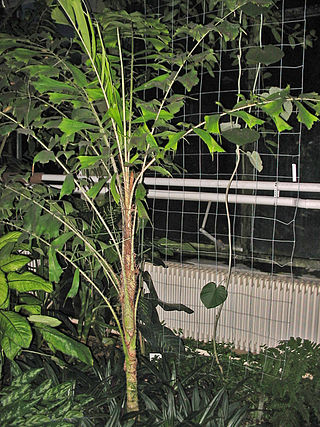
Aiphanes is a genus of spiny palms which is native to tropical regions of South and Central America and the Caribbean. There are about 26 species in the genus, ranging in size from understorey shrubs with subterranean stems to subcanopy trees as tall as 20 metres (66 ft). Most have pinnately compound leaves ; one species has entire leaves. Stems, leaves and sometimes even the fruit are covered with spines. Plants flower repeatedly over the course of their lifespan and have separate male and female flowers, although these are borne together on the same inflorescence. Although records of pollinators are limited, most species appear to be pollinated by insects. The fruit are eaten by several birds and mammals, including at least two species of amazon parrots.

Clethra is a genus of flowering shrubs or small trees described as a genus by Linnaeus in 1753.
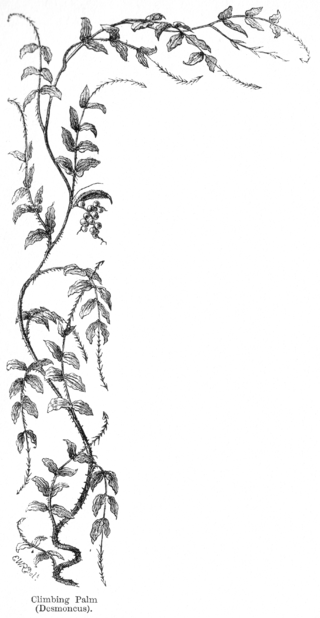
Desmoncus is a genus of mostly climbing, spiny palms native to the Neotropics. The genus extends from Mexico in the north to Brazil and Bolivia in the south, with two species present in the southeastern Caribbean.

Oenocarpus is a genus of pinnate-leaved palms (Arecaceae) native to Trinidad, southern Central and tropical South America. With nine species and one natural hybrid, the genus is distributed from Costa Rica and Trinidad in the north to Brazil and Bolivia in the south.

Eschweilera is a genus of woody plants in the family Lecythidaceae first described as a genus in 1828. It is native to southern Mexico, Central America, South America, and Trinidad.

Ophryosporus is a genus of South American flowering plants in the tribe Eupatorieae within the family Asteraceae.

Wettinia is a genus of flowering plants in the palm family Arecaceae. The genus, established in 1837, contains some 20 species, but more seem to await discovery considering that 4 species - W. aequatorialis, W. lanata, W. minima and W. panamensis - were described as late as 1995. The genus is broadly divided into two groups. One group has the fruits tightly packed, while the other, formerly classified as genus Catoblastus, has fruits scattered along the inflorescence branches. It is not known whether these groups are both monophyletic. The genus is named after Frederick Augustus II of Saxony, of the House of Wettin.

Gustavia is a genus of flowering plants in the family Lecythidaceae described by Linnaeus in 1775. It is native to tropical Central America and South America. Many of the species are threatened; some are critically endangered Gustavia superba, though, is actually abundant in re-growing secondary forests. It grows in northern South America, from Panama south through the Andes as far as Ecuador, and along the Caribbean coast and in the Amazon basin. Gustavia flowers have numerous stamens, in some species as many as 1,200 in a single flower.

Brunellia is a genus of trees. They are distributed in the mountainous regions of southern Mexico, Central America, West Indies, and South America. Brunellia is the only genus in the family Brunelliaceae. As of 2001 there were about 54 species.
Rostkovia is a genus of plant in family Juncaceae described as a genus in 1809.

Minthostachys is a genus of the mint family Lamiaceae, comprising aromatic scandent shrubs. It occurs along the Andes from Northern Venezuela through Colombia, Ecuador, Peru and Bolivia to Central Argentina.

Laennecia or Laënnecia is a genus of flowering plants in the family Asteraceae. The plants are native to Mesoamerica, South America, and the southwestern United States. Common name is "horseweed."
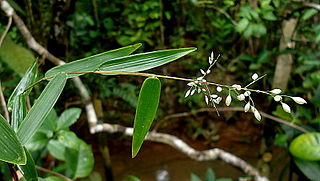
Parodiolyra is a genus of Neotropical plants in the grass family.
- Parodiolyra aratitiyopensisJ.R.Grande - Venezuela (Amazonas)
- Parodiolyra colombiensisDavidse & Zuloaga - Colombia (Caquetá)
- Parodiolyra lateralis(J.Presl ex Nees) Soderstr. & Zuloaga - Nicaragua, Costa Rica, Panama, Colombia, Venezuela, Guyana, Suriname, Ecuador, Peru, Brazil
- Parodiolyra luetzelburgii(Pilg.) Soderstr. & Zuloaga - Brazil, Colombia, Venezuela, Guyana, Suriname, French Guiana
- Parodiolyra micrantha(Kunth) Davidse & Zuloaga - Brazil, Colombia, Venezuela, Guyana, Suriname, French Guiana, Peru, Bolivia, Argentina, Paraguay
- Parodiolyra ramosissima(Trin.) Soderstr. & Zuloaga - Brazil (Bahia)

Dunalia is a genus of flowering plants belonging to the family Solanaceae.
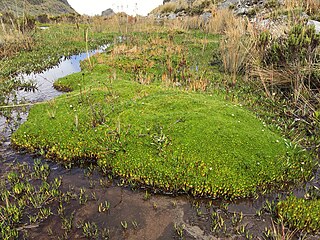
Distichia muscoides is a species of plant in the rush family Juncaceae. It is native to the Andes of South America where it grows in upland wetland areas known as bofedales.



















